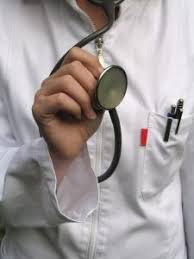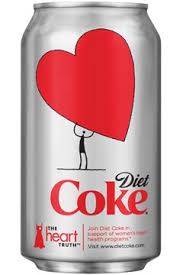February 21st, 2011 by Toni Brayer, M.D. in Health Tips, Opinion
No Comments »

 “But doc, my blood pressure is always normal at home.” I wish I had a dollar for every time I have heard that line and I know it is true. When some patients come to see me, their blood pressure is abnormally high (above 130/90). This is known as “white-coat hypertension.” Although it has been thought to be from anxiety about seeing the doctor, even long-established patients who have no conscious anxiety can exhibit elevated blood pressure in the office.
“But doc, my blood pressure is always normal at home.” I wish I had a dollar for every time I have heard that line and I know it is true. When some patients come to see me, their blood pressure is abnormally high (above 130/90). This is known as “white-coat hypertension.” Although it has been thought to be from anxiety about seeing the doctor, even long-established patients who have no conscious anxiety can exhibit elevated blood pressure in the office.
Because blood pressure naturally fluctuates and the office visit is not a “normal” setting, it is important for patients who have high blood pressure (hypertension) to have their own blood pressure cuff at home. Now that devices are automated and easy to use, everyone with hypertension should be monitoring their blood pressure in the comfort of their own home. I advise multiple readings over a week at different times of day. Get a reading when resting and when rushing around. Take your blood pressure after you exercise and after a meal. It is important to keep a log and write it down. Only then can we see patterns and know if the blood pressure is controlled or not.
Blood pressure readings in the doctors office are not necessarily the most accurate. Patients are often rushed trying to get parked and in on time. Medical assistants can use the wrong size cuff or not position the arm correctly. Listening (auscultation) is not very accurate due to human error. It is the multiple readings over time that give a more accurate picture of blood pressure control.
High blood pressure in the office can be true hypertension or it can be white-coat hypertension that is usually controlled at home. If a patient is on blood pressure medication and has controlled blood pressure at home, I will not add more medication just because they are elevated in the office. If a patient has not been diagnosed with hypertension and his or her blood pressure is elevated in the office, he or she is advised to get their own blood pressure cuff for at home and return with readings for us to review. This way we can minimize unnecessary and expensive medication and make sure we are protecting the patient as well.
*This blog post was originally published at EverythingHealth*
February 20th, 2011 by John Mandrola, M.D. in Opinion, Research
No Comments »

 It tastes sweet. It’s pleasurably fizzy. And free of calories. What’s more, the FDA says NutraSweet (aspartame) is safe. So what’s not to like about diet soft drinks?
It tastes sweet. It’s pleasurably fizzy. And free of calories. What’s more, the FDA says NutraSweet (aspartame) is safe. So what’s not to like about diet soft drinks?
A bunch. The ongoing debate about the healthiness of diet soft drinks reminds me of the old adage, “If something sounds to be true, it probably is.”
Artificially-sweetened “diet” drinks get touted as healthy alternatives to sugary drinks because they contain no calories or carbohydrates. On paper it seems plausible to think they are inert, no more dangerous than water. The Coca-Cola Company sublimely strengthens this assertion by putting a big red heart on Diet Coke cans.
But diet-cola news (Los Angeles Times) presented at the International Stroke Conference 2011 suggests otherwise. This widely-publicized observational study of 2,500 older patients (average age=69) from New York showed that drinking diet soda on a daily basis increased the risk of having a heart attack or stroke by 61 percent. The abstract — not a peer-reviewed study — stated that this association persisted after controlling for other pertinent variables.
Sure, this is only a look back at 559 patients who had a vascular event. The study asserts only an association, not that diet colas cause heart attacks and strokes. That’s a big difference.
That said, however, I don’t view these results as trivial either. This trial builds on the results of prior studies of diet drinks which strongly suggest that despite their lack of calories, diet drinks don’t prevent obesity. Read more »
*This blog post was originally published at Dr John M*
February 18th, 2011 by Mary Knudson in News, Opinion
No Comments »

This was the Guest Blog at Scientific American on February 16th, 2011.
New wave of MRI-safe pacemakers set to ship to hospitals
This week Medtronic will begin shipping to hospitals in the United States the first pacemaker approved by the FDA as safe for most MRI scans. For consumers, it is a significant step in what is expected to be a wave of new MRI-compatible implanted cardiac devices.
But this is an example of one technology chasing another and the one being chased, the MRI scanner, is changing and is a step ahead of the new line of pacemakers. The pacemaker approved for U.S. distribution is Medtronic’s first-generation pacemaker with certain limitations, while its second-generation MRI-compatible pacemaker is already in use in Europe where approval for medical devices is not as demanding as it is in the U.S. So let’s check out what this is all about — what it means now for current and future heart patients and where it may be headed.
We are all born with a natural pacemaker that directs our heart to beat 60 to 100 times a minute at rest. The pacemaker is a little mass of muscle fibers the size and shape of an almond known medically as the sinoatrial node located in the right atrium, one of four chambers of the heart. The natural pacemaker can last a lifetime. Or it can become defective. And even if it keeps working normally, some point may not function well along the electrical pathway from the pacemaker to the heart’s ventricles which contract to force blood out to the body.
Millions of people in the world whose hearts beat too fast, too slow, or out of sync because their own pacemaker is not able to do the job right, follow their doctors’ recommendation to get an artificial pacemaker connected to their heart to direct its beating. The battery-run pacemaker in a titanium or titanium alloy case the size of a small cell phone, (why can’t it be the size of an almond?) is implanted in the upper left chest, just under the skin, with one or two insulated wire leads connecting to the heart. It can be programmed to run 24/7 or to only operate when the heart reaches a certain state of irregular beating. Read more »
*This blog post was originally published at HeartSense*
February 13th, 2011 by AnnMacDonald in Better Health Network, Health Tips
1 Comment »

 This is the time of year when stores are filled with red hearts and other reminders that Valentine’s Day is approaching. It’s a mood booster, not to mention a nice break from all that winter grey (at least up here in Boston). After all, what would life be like without romance, love — and sex?
This is the time of year when stores are filled with red hearts and other reminders that Valentine’s Day is approaching. It’s a mood booster, not to mention a nice break from all that winter grey (at least up here in Boston). After all, what would life be like without romance, love — and sex?
Unfortunately, a variety of health problems — as well as some of the treatments for them — can get in the way of sexual desire and functioning. Here’s a quick look at some of the main sources of trouble and suggestions about what to try first. If these initial strategies don’t work, have a heart to heart with your doctor about what to do next. There may not be a quick fix for health-related sexual problems, but there are steps you can take to help ensure that you can still enjoy a love life while taking care of the rest of your health.
Arthritis
Arthritis comes in many guises, but most forms of this disease cause joints to become stiff and painful. The limitations on movement can interfere with sexual intimacy — especially in people with arthritis of the knees, hips, or spine.
One common solution is to try different positions to find a way to make sex physically more comfortable. Another option is to take a painkiller or a warm shower before sex to ease muscle pain and joint stiffness. Or try a waterbed — which will move with you.
You can read more online by viewing this helpful article posted by the American College of Rheumatology.
Cancer
Cancer treatment may have long-term impact on sexual desire and functioning. Surgery or radiation in the pelvic region, for example, can damage nerves, leading to loss of sensation and inability to have an orgasm in women and erectile dysfunction in men. Chemotherapy can lower sex drive in both men and women. Read more »
*This blog post was originally published at Harvard Health Blog*
February 12th, 2011 by RyanDuBosar in News, Research
No Comments »

 Enriched chicken feed may have resulted in eggs having less cholesterol and more Vitamin D than previously measured, reports the U.S. Department of Agriculture (USDA).
Enriched chicken feed may have resulted in eggs having less cholesterol and more Vitamin D than previously measured, reports the U.S. Department of Agriculture (USDA).
A large egg today has about 185 milligrams of cholesterol, down 14 percent from 215 milligrams in 2002, according to new research from the USDA’s Agricultural Research Service, reports USA Today. Also, an egg today has 41 international units (IUs) of Vitamin D, up 64 percent from 25 IUs measured in 2002. (That’s still only about 7 percent of the 600 IUs recommended per day.)
The agency regularly does nutrient checks on popular foods, this time analyzing eggs taken from store shelves in 12 locations around the country. The American Egg Board said in a press release that hen feed is made up mostly of corn, soybean meal, vitamins and minerals. Nutrition researchers at Iowa State University are also looking into reasons why cholesterol in eggs is decreasing.
The government’s “Dietary Guidelines for Americans” recommend that most people eat less than 300 milligrams of total dietary cholesterol a day, and people at a high risk of cardiovascular disease should eat less than 200 milligrams a day. The average American man consumes about 337 milligrams of cholesterol a day and the average woman consumes 217 milligrams, reports the Los Angeles Times.
One egg a day fits within the average, healthy American’s diet, reports WebMD, citing research funded by the Centers for Disease Control and Prevention and by the American Egg Board — owners of the slogan “the incredible, edible egg.”
*This blog post was originally published at ACP Internist*
“But doc, my blood pressure is always normal at home.” I wish I had a dollar for every time I have heard that line and I know it is true. When some patients come to see me, their blood pressure is abnormally high (above 130/90). This is known as “white-coat hypertension.” Although it has been thought to be from anxiety about seeing the doctor, even long-established patients who have no conscious anxiety can exhibit elevated blood pressure in the office.



















